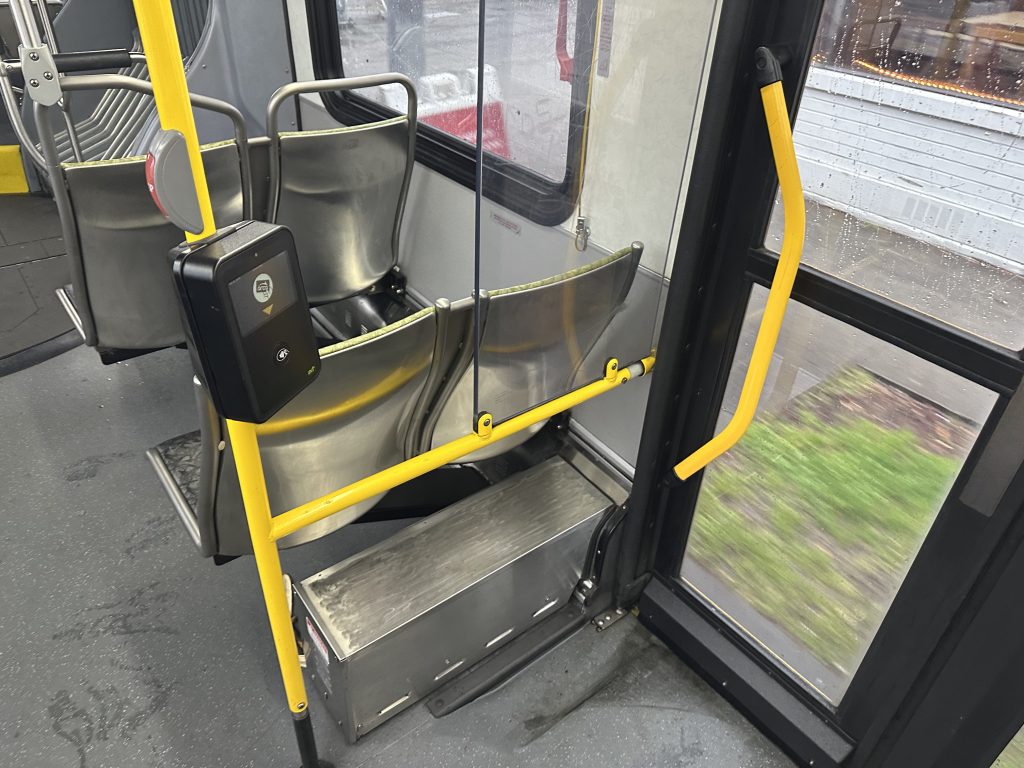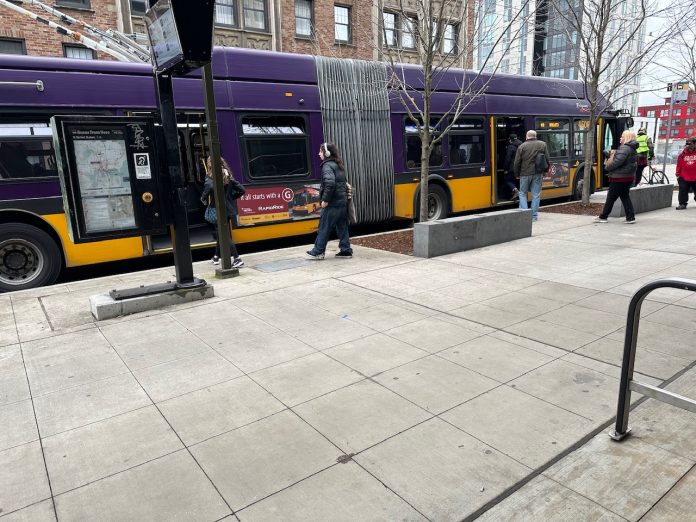While Metro is working toward a universal all-door boarding system, for now it’s keeping its front-door policy at most bus stops.
If you’ve ridden a King County Metro bus recently, there’s a good chance that it had an ORCA card reader at each door. The agency has been rolling them out as it advances toward an all-door boarding system to improve speed and reliability. When the policy change will be made, however, has not yet been announced.
Unofficially, operators on local bus routes have been allowing riders to board at mid- and rear-doors and to use nearby ORCA readers to pay fares. That’s a common occurrence at bus stops in bustling neighborhoods like the University District where there is often a heavy turnover of riders getting off and on buses.
Current Metro protocols officially only permit all-door boarding on RapidRide lines and bus routes operating along Third Avenue in Downtown Seattle. That’s because RapidRide lines were designed to operate that way and equipped with onboard ORCA readers at all doors and offboard ORCA readers at select stops while stops on Third Avenue also have offboard ORCA readers.
“We continue to install rear-door ORCA readers, which are on nearly 75% of our buses,” Jeff Switzer, a Metro spokesperson, told The Urbanist. “However, we have not formally transitioned to using them or approved them for service. Transit operators have not been instructed to operate any differently, and will be given specific instructions once we are fully prepared to make the switch to all-door boarding.”

Switzer said that Metro maintenance staff have been installing the extra ORCA readers on buses as time permits since late 2022, with a goal to complete fleet-wide installation by the end of this year.
“Metro adjusted the implementation of all-door boarding to allow for the resumption of fare inspection activities and to complete installation of the remaining onboard ORCA readers,” Switzer added. Originally, the agency had a 2024 implementation timeline in mind for all-door boarding.
Metro will reinstate regular fare inspection on buses throughout the network at the end of the month, after a five-year hiatus, which was first enacted as a pandemic distancing precaution. Initially, the agency will focus on RapidRide and Third Avenue bus routes, but fare enforcement may be deployed to other routes in the system. Deployment plans are still being finalized.
As a precursor to implementation of all-door boarding throughout the system, Switzer said that the agency would be revisiting plans in the coming months to enable the changes. Formal protocols for all-door boarding will take in account things like bus stop conditions, such as landscaping and access.
Each ORCA reader costs about $2,500 to procure and install, bringing the full program cost to a little over $5 million.
When the all-door program is ultimately implemented, Metro anticipates seeing real operational benefits.
“Metro consulted national and international studies when considering the potential time savings from opening all doors,” Switzer said. “Most studies were conducted prior to 2020, when peak-hour commuting patterns were more prevalent. Transit use patterns have changed since then, but we still expect to see time savings as riders and operators adjust to boarding at all-doors. Once implemented, it will be easier to assess time savings, likely by looking at dwell time at stops.”
While riders are likely to continue using all doors to board local buses when they can, Metro’s official stance is ‘please use the front door.’
“Metro continues to direct customers to board and pay their fare at the front of the bus,” Switzer said. “Or using offboard ORCA readers, where available, or using all doors on RapidRide buses.”
Stephen is a professional urban planner in Puget Sound with a passion for sustainable, livable, and diverse cities. He is especially interested in how policies, regulations, and programs can promote positive outcomes for communities. With stints in great cities like Bellingham and Cork, Stephen currently lives in Seattle. He primarily covers land use and transportation issues and has been with The Urbanist since 2014.



